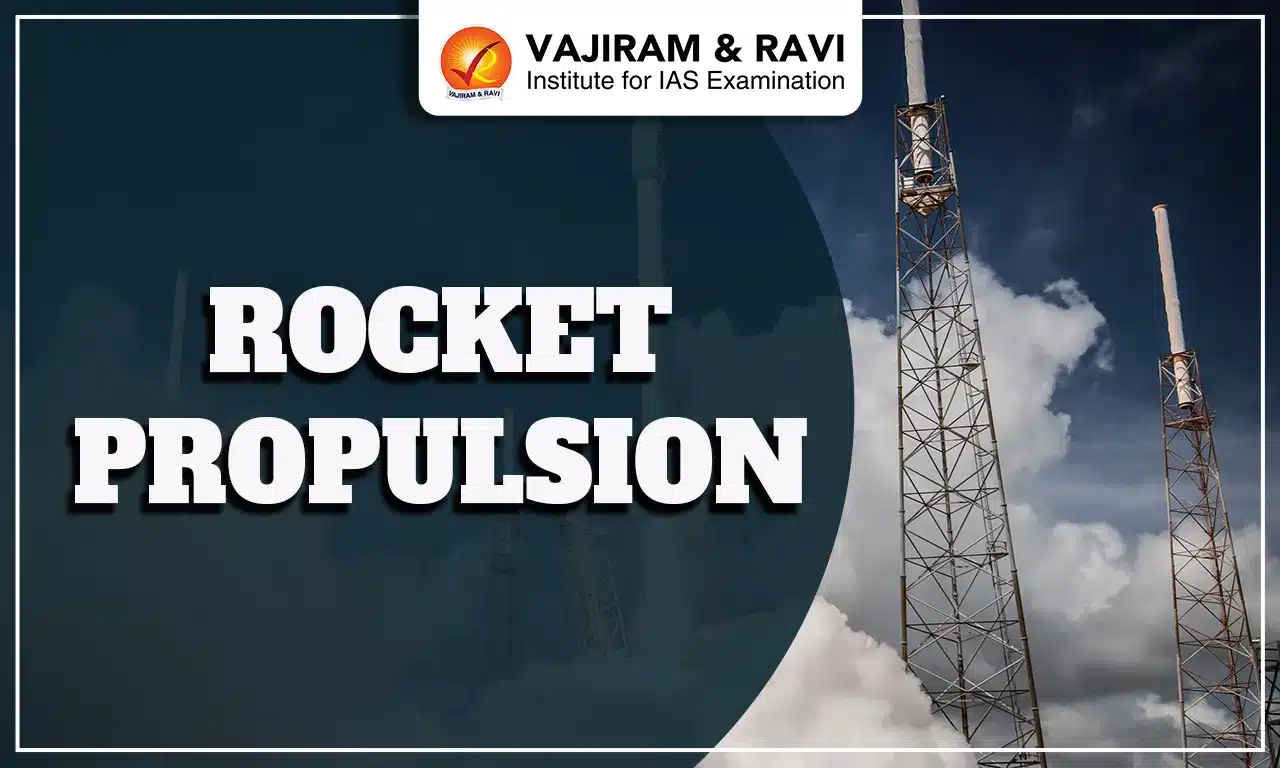A rocket comprises four primary elements: the structural system, also known as the frame, the payload system, the guidance system, and the propulsion system. Rocket propulsion systems are the engines responsible for generating the thrust needed to propel rockets, including satellite launch vehicles, into space.
These rocket propulsion systems are fundamental in the field of aerospace engineering and have evolved over the years to become highly efficient and powerful.
Rocket Propulsion System
A rocket propulsion system is an engine that provides thrust to a rocket. It works by ejecting fuel at high speed from the back of the rocket, which produces an equal and opposite force that propels the rocket forward.
Principle and Working of Rocket Propulsion
Newton's third law of motion, which states that every action has an equal and opposite reaction, is one of the principles underlying rocket propulsion. When a rocket ejects propellant at high speed from the back, it produces an equal and opposite force that propels the rocket forward.
- For instance, when standing on a skateboard and throwing something heavy away from you, the skateboard moves in the opposite direction. The rocket works the same way.
- The force created by the ejected gases is called thrust. The more thrust a rocket has, the faster it goes.
- In a rocket engine, fuel and an oxidizer are burned to produce hot exhaust gas.
- The hot exhaust gas from the rocket accelerates to the back of the rocket after passing through the nozzle. On the engine mount, a thrusting force is generated in response.
- Newton's second law of motion describes how the thrust accelerates the rocket.
- The amount of thrust produced by a rocket is determined by the mass flow rate of the propellant and the exhaust velocity.
- The mass flow rate is the rate at which the fuel is ejected from the rocket, and the exhaust velocity is the speed at which the fuel exits the nozzle.
- The exhaust velocity of a rocket is determined by the type of propellant used and the design of the nozzle.
- The nozzle is a tapered tube that accelerates the exhaust gases to high speeds. The higher the exhaust velocity, the more thrust the rocket will produce.
- Ramjet and Scramjet engines also work on the same principle as rocket propulsion systems.
Rocket Propulsion Diagram
A structure of a rocket propulsion system typically involves several key components, which include the payload system, fuel and oxidiser, combustion chamber and nozzle. Following is the given representation of the rocket propulsion system.
Types of Rocket Propulsion System
There are four main types of rocket propulsion systems. These are given as follows:
Solid Fuel Chemical Propulsion
- Mechanism: The solid motor is primarily used as a launch vehicle booster. Because they are uncontrollable, solid motors are almost never used in space. The boosters are ignited and then fired until all of the propellants have been consumed.
- Significance: Their primary advantages are simplicity, a shelf life that can last years, as in the case of missiles, and high reliability.
- Example: NASA’s Space Launch System Solid Rocket Booster is one of the largest and most powerful solid propellant boosters.
- Kalam-5: In 2020, Skyroot Aerospace successfully tested a solid propulsion rocket stage called Kalam-5.
- It is made of an advanced carbon composite structure that is five times lighter than a steel case.
- It made Skyroot Aerospace the first private player in India to design and test a full solid propulsion rocket stage.
Liquid Fuel Chemical Propulsion
- Significance: Liquid motors are available in a variety of shapes and sizes. The majority of them are controllable (they can be throttled up and down) and restartable, and they are frequently used as control and maneuvering thrusters.
- Types: There are three types of liquid thrusters: monopropellant, bipropellant, and cryogenic thrusters. Thruster complexity and performance increase with each step, from monopropellant to bipropellant to cryogenic.
- Monopropellant: A single propellant, such as hydrazine, is used in monopropellants. Bipropellants make use of a fuel and an oxidizer like RP-1 and H2O2.
- Bipropellant: Liquid gases such as LiH and LOX (liquid hydrogen and liquid oxygen) are used in cryogenic systems.
- Cryogenic thrusters: Cryogenic refers to extremely cold temperatures. To make hydrogen and oxygen liquids, they would have to be supercooled.
- Cryogenic technology is the science of producing, storing, transporting, and using materials at extremely low temperatures.
- Example: The SpaceX Merlin engine is a liquid-fuel rocket engine used to power the Falcon 9 and Falcon Heavy rockets.
- Vikas Engine:
- The Vikas engine (Vikram Ambalal Sarabhai) is a family of liquid-fueled rocket engines developed in the 1970s at ISRO's Liquid Propulsion Systems Centre.
- It powers the second stages of the PSLV and the GSLV, as well as the GSLV's liquid strapons and the core liquid stage of the LVM3.
- ISRO’s semi-cryogenic engine:
- Recently, ISRO successfully test-fired its semi-cryogenic engine at the ISRO Propulsion Complex (IPRC) in Mahendragiri.
- Semi-cryogenic engines are propulsion technologies that use refined kerosene (known as 'ISROsene') and super-cooled liquid oxygen.
Cold-Gas Chemical Propulsion
- Mechanism:
- Cold-gas motors have the same controllability as liquids but are simpler and lighter.
- They are essentially high-pressure tanks with switches that alternate between open and closed states.
- They work a little like spray paint, with the contents under pressure inside and streaming out when the valve is opened.
- Example: The SpaceX Falcon 9 rocket uses cold-gas thrusters for attitude control during flight's first and second stages.
Ion Engines
- Mechanism: Ion engines differ significantly from chemical (solid, liquid) engines in that they have low thrust and can run for extended periods of time.
- Significance: Chemical engines are typically used for a few seconds to a few days, whereas ion engines can be used for days to months.
- Example: BepiColombo, a joint mission between the ESA and the JAXA to study Mercury, is using ion engines to travel to Mercury.
Recent Developments in Rocket Propulsion System
Rocket propulsion systems have advanced significantly over the years, resulting in increased efficiency and power. These advancements include hybrid propulsion systems, space nuclear propulsion, etc.
Hybrid Propulsion System
- Mechanism: A hybrid propulsion system is any vehicle propulsion system that combines two or more sources of propulsion into a single design and can be used simultaneously or alternately.
- Significance:
- The hybrid system is more efficient, greener, and safer to operate, and it paves the way for future missions to use new propulsion technologies.
- Use of hybrid propulsion can save fuel, increase average engine load, reduce maintenance costs, increase uptime, etc.
- Hybrid vehicles, for example, use the gasoline engine as a generator to power the electric motor. This allows them to use less petrol than conventional vehicles.
- ISRO’s Hybrid Propulsion System:
- In September 2022, the Indian Space Research Organisation (ISRO) successfully demonstrated a hybrid propulsion system from the ISRO Propulsion Complex (IPRC), Mahendragiri.
- The hybrid propulsion system by ISRO used Hydroxyl-terminated polybutadiene (HTPB)-based aluminised solid fuel and liquid oxygen (LOX) as the oxidiser.
Space Nuclear Propulsion
- Mechanism: It is a propulsion technology that can provide high thrust while also doubling propellant efficiency, making it a viable option for crewed missions to Mars.
- The heat from the reactor is transferred directly to a gaseous hydrogen propellant in the system. To propel a spacecraft, heated hydrogen expands through a nozzle.
- Significance: It would enable more flexible abort scenarios, allowing the crew to return to Earth at various times, including immediately upon arrival at Mars.
Rotating Detonation Rocket Engine (RDRE)
- Mechanism: It is a new propulsion system by NASA. It generates thrust by rapidly rotating and detonating a fuel-and-oxidizer mixture in a continuous combustion cycle.
- Significance: It has the potential to power both human landers and interplanetary vehicles travelling to deep space destinations such as Mars and the Moon.
Last updated on November, 2025
→ Check out the latest UPSC Syllabus 2026 here.
→ Join Vajiram & Ravi’s Interview Guidance Programme for expert help to crack your final UPSC stage.
→ UPSC Mains Result 2025 is now out.
→ UPSC Notification 2026 is scheduled to be released on January 14, 2026.
→ UPSC Calendar 2026 is released on 15th May, 2025.
→ The UPSC Vacancy 2025 were released 1129, out of which 979 were for UPSC CSE and remaining 150 are for UPSC IFoS.
→ UPSC Prelims 2026 will be conducted on 24th May, 2026 & UPSC Mains 2026 will be conducted on 21st August 2026.
→ The UPSC Selection Process is of 3 stages-Prelims, Mains and Interview.
→ UPSC Result 2024 is released with latest UPSC Marksheet 2024. Check Now!
→ UPSC Prelims Result 2025 is out now for the CSE held on 25 May 2025.
→ UPSC Toppers List 2024 is released now. Shakti Dubey is UPSC AIR 1 2024 Topper.
→ UPSC Prelims Question Paper 2025 and Unofficial Prelims Answer Key 2025 are available now.
→ UPSC Mains Question Paper 2025 is out for Essay, GS 1, 2, 3 & GS 4.
→ UPSC Mains Indian Language Question Paper 2025 is now out.
→ UPSC Mains Optional Question Paper 2025 is now out.
→ Also check Best IAS Coaching in Delhi
Tags: quest rocket propulsion



















